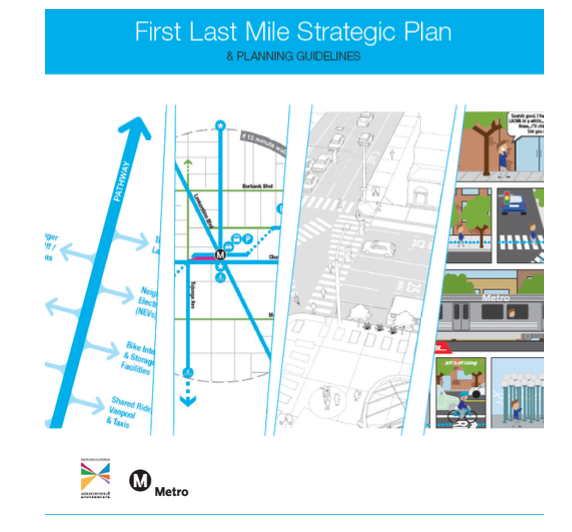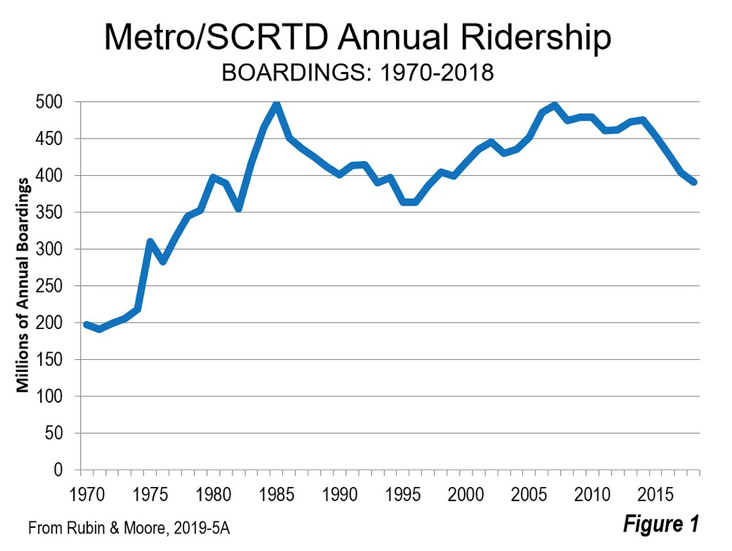CommentsPLANNING WATCH-A municipal version of the dog bites man story surfaced last week, with another METRO report that ridership on buses, subways, and light rail has declined yet again.
Excuses and partial explanations abound, such as:
- Ridership will eventually increase when the rail system is fully built out, yet continued rail construction has led to steady declines in transit ridership over the past decade.
- Immigrants prefer to drive cars, not take transit, yet these same immigrants previously lived in countries where they relied on public transportation.
- If cities build more housing near transit lines, people will then take the transit. This explanation certainly qualifies for a front row seat on Joe Biden’s No Malarkey campaign bus. Transit-adjacent apartments are mushrooming throughout Los Angeles, especially in Hollywood, DTLA, Koreatown, Miracle Mile and Fairfax, and Warner Center, yet the bus and subway lines in these areas have some of METRO’s most severe ridership declines. In Hollywood Red Line subway boardings have declined around 20 percent over the past three years.
- Los Angeles has such a pervasive automobile culture that it is impossible to persuade Angelinos to ditch their cars for buses, light rail, and subways. Yet, this cultural constant would not result in steadily declining transit ridership. Furthermore, LA’s car culture began in the 1920s, and Los Angeles had the country’s largest mass transit system through the 1950s.
Flawed planning decisions have resulted in declining transit ridership. These partial explanations are either wrong or peripheral to the real explanation. City Hall and METRO officials, with the support of their professional staff, have made numerous flawed decisions that have driven ridership down, not up. We are not talking about Acts of God, black swan events, human nature, immigration, or LA’s automobile culture, but cumulative, wrong-headed planning decisions that have resulted in and will continue to result in declining transit ridership.
The proposed Purple Line Extension Transit Neighborhood (Specific) Plan (TNP) is the poster child for this approach. So please indulge me as I again explain how the TNP – if the City Council adopts it and the City Attorney can fend off certain lawsuits – would further drive down transit ridership for decades to come.
Fatal Flaw #1. The TNP promotes high-rent market housing in lieu of low-income housing. At present Los Angeles offers developers easy workarounds to build auto-centric structures that exceed the height, size, and density requirement of LA’s zoning laws. These include discretionary zoning waivers, which sail through City Hall 90 percent of the time, plus never-inspected density bonuses that allow substantial increases in a building’s size, height, and density. In the case of the TNP, the proposed Specific Plan would be nothing more than an up-zoning ordinance. Furthermore, this approach has been buttressed by a METRO-paid-for real estate market study. If the City Council adopts these new zones, developers could easily skip over discretionary approvals or density bonuses to build larger, taller, denser, and obviously more expensive buildings as by-right ventures. What a deal!
Fatal Flaw #2. The TNP totally ignores METRO’s and LA City Planning’s first-last mile on-site and corridor improvements to promote transit use. METRO’s first-last mile policies clearly require coordinated public improvements to be part of transit projects, such as the Purple Line Extension. These first-last mile policies are clearly spelled out in numerous METRO documents, and they are also referenced in the successive planning grants that METRO gave the City of Los Angeles for its five Transit Neighborhood Plans. Yet, there are no first-last mile transit enhancements at the Purple Line Extension stations and in adjacent areas, including the bicycle and pedestrian improvements listed in the initial City Council motion. These missing first-last mile amenities include station stores and bathrooms, kiss ‘n ride zones, on-site park ‘n ride parking lots, station interfaces for pedestrians and buses, bicycle and scooter lanes and parking areas, sidewalk and intersection repairs, bus shelters, shade trees, and even wayfaring signs.

METRO rejects its own first-last mile policies for the
Purple Line Extension Transit Neighborhood Plan.
Furthermore, the City of Los Angeles has parallel policies and guidelines for public improvements to draw people out of their cars and onto rail, buses, bicycles, and sidewalks. Although LA City Planning prepared and posted LA’s Mobility Hubs and Complete Streets Design Guidelines on its website, City Hall also ignored its own first-last mile policies and programs for the TNP, even though Complete Streets has been a California planning law since 2008.
Fatal Flaw #3. The TNP evades LA’s legally required community planning update process. Even though City Planning will finalize the TNP in parallel with the update of the Wilshire Community Plan -- planning for the same area at the same time for the same horizon year of 2040 – City Hall has so far dug in its heels. The TNP’s zoning code amendments will be walled off from the surrounding update of the Wilshire Community Plan. As a result, the Transit Neighborhood Plan’s unplanned reductions to zoning laws would preempt the simultaneous update of the Wilshire Community Plan.
The TNP will ignore the Wilshire Community Plan Update’s data for housing, employment, transportation, population, zoning capacity buildout, infrastructure, and code enforcement. This chicanery bestows a lucrative gift to property owners, unplanned up-zones to increase the value of prime commercial parcels.
The interaction of these three Purple Line Extension TNP planning approaches will have real world consequences. They ensure that most of those who will live near the Purple Line Extension subway and adjacent bus corridors would be the least likely residents to use transit. Given the high rents they can afford, they will continue to rely on cars – whether their own or ubers -- for mobility.
Furthermore, early adapters who nevertheless choose to take the subway or local busses must overcome many easily prevented barriers:
- If prospective passengers make it to subway stations, they will discover that such basic amenities as toilets and kiosks are missing.
- If passengers drive, they their own cars to subway stations, there will be no on-site parking.
- If passengers take buses, Ubers, or personal cars to the stations, there will be no drop-off zones.
- If passengers walk to bus stops or new subway stations, there will be no wayfaring signs or shade trees on the broken, mismatched sidewalks.
- If passengers choose to bike or take scooters, they will discover that the lack of bike lanes and parking areas, as well as the failure to include METRO’s Bike Share program at the Purple Line subway stations.
- If passengers approach employers or landlords for transit subsidies, they will discover that neither METRO nor the City of Los Angeles require them to furnish employees or residents TAP cards.
It isn’t easy to plan for failure, but these three fatal flaws show that when self-inflicted blindness serves real estate interests, it can occasionally succeed.
NOTE: To research this article, I contacted METRO and City Planning staff for information on Purple Line Extension first-last mile public improvements. I eventually received a call back from a METRO public relations contact. He wanted to know the purpose of my article but did not answer my questions.
(Dick Platkin is a former Los Angeles city planner who reports on local planning issues for CityWatch. He serves on the board of United Neighborhoods of Los Angeles (UN4LA) and welcomes comments and corrections at [email protected]. Selected previous columns are available at the CityWatch archives and the Plan-it Los Angeles blog.) Prepped for CityWatch by Linda Abrams.
